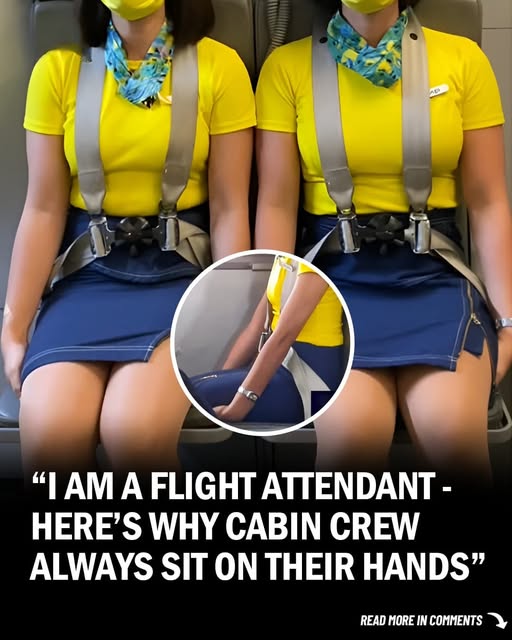Flight attendants are often seen as the face of air travel, offering passengers comfort, safety, and assistance throughout their journey. But their responsibilities go far beyond serving snacks and drinks. They are highly trained professionals responsible for ensuring the safety and security of everyone on board. Among the many safety protocols they follow, one seemingly peculiar habit often catches passengers’ attention: flight attendants keeping their hands behind their backs during takeoff and landing.

This posture isn’t random; it serves a crucial purpose. Henny Lim, a flight attendant with Cebu Pacific, shed light on this practice in a viral TikTok video. Lim explained that the stance is not only intentional but also part of critical safety protocol. The pose involves standing upright with feet firmly planted, hands behind the back, and shoulders squared. It might seem overly formal, but every detail of this stance is carefully thought out.
The primary reason flight attendants keep their hands behind their backs during takeoff and landing is to discreetly count passengers. Hidden from view, they often hold a small clicker or counter in their hand to ensure the number of passengers matches the manifest. This quick count ensures everyone is accounted for before the most critical phases of flight begin. It also allows them to remain observant and focused without alarming passengers or drawing unnecessary attention.
Another reason for this posture is preparedness. By keeping their hands behind their backs, flight attendants can quickly respond to emergencies without fumbling or being caught off guard. This stance allows them to maintain balance, stability, and readiness in case something goes wrong during takeoff or landing—statistically the riskiest phases of any flight.
The bracing position is another critical protocol flight attendants follow during these moments. Once seated in their jump seats, they secure their seatbelts tightly, sit upright, and keep their hands on their thighs with their thumbs tucked in. This position minimizes body movement during impact, reduces the risk of flailing limbs, and helps protect vital organs. During this time, flight attendants also conduct what’s known as a “silent review.” This mental exercise involves running through emergency procedures, door operations, and evacuation commands while staying highly alert and focused on their surroundings.
Regulatory bodies like the Federal Aviation Administration (FAA) emphasize the importance of these safety practices. According to FAA guidelines, the bracing stance serves two key purposes: minimizing flailing and reducing secondary impact injuries. When limbs are uncontrolled during a sudden stop or crash, they can cause severe injuries. Additionally, pre-positioning the body, especially the head, against the nearest surface reduces the force of secondary impact.
In recent years, social media platforms like TikTok have become valuable tools for flight attendants to educate the public about these protocols. Flight attendants like Henny Lim and others have gained large followings by sharing behind-the-scenes insights, safety tips, and personal experiences from life in the skies. These videos not only satisfy public curiosity but also highlight the intense training and preparation that goes into the job.
While passengers may sometimes focus on the glamour or travel perks associated with being a flight attendant, the reality is far more complex. The job demands physical endurance, emotional resilience, and constant alertness. Challenges include managing unruly passengers, handling emergencies, and adapting to irregular sleep schedules. Yet, many flight attendants express deep gratitude for their careers, emphasizing the rewarding aspects of helping passengers and ensuring their safety.
The seemingly simple gesture of keeping hands behind the back during takeoff and landing is, in reality, a small part of a much larger safety protocol. It demonstrates the attention to detail, discipline, and professionalism required in the role. Flight attendants are not just service providers; they are highly trained safety experts who are prepared to act swiftly and effectively in critical situations.
Next time you board a plane and notice a flight attendant standing with their hands behind their back, remember that it’s not just a pose—it’s a calculated safety measure designed to ensure a smooth and secure flight experience. Their calm demeanor and precise actions are part of a larger system built to protect every passenger on board. In recognizing their dedication, passengers can better appreciate the critical role flight attendants play in making air travel safe and reliable for everyone.





